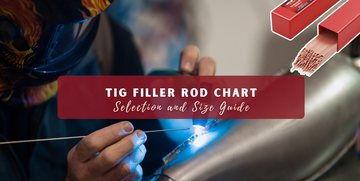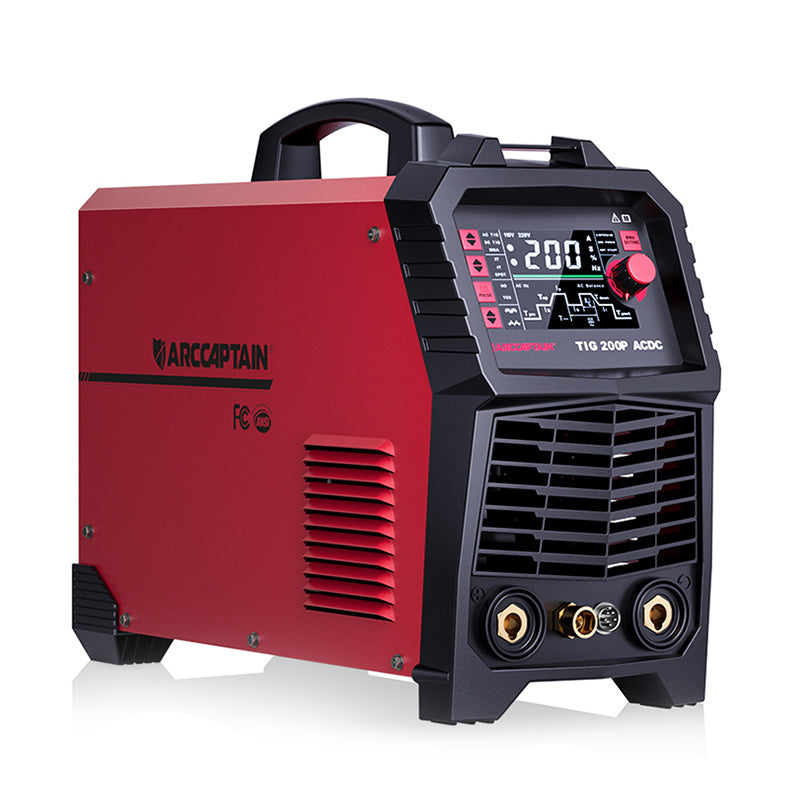
Choosing the right TIG filler rod size and type is one of the most important decisions a welder can make. Whether you're working on carbon steel, stainless steel, or aluminum, the correct filler rod ensures stronger, cleaner welds with fewer defects. Using the wrong size or alloy can cause problems like cracking, weak joints, or poor appearance.
In this article, you’ll learn everything about selecting TIG welding filler rods including sizing, matching alloy types, and usage tips. We also include helpful charts that simplify the decision process so you know exactly which rod to pick for your welding projects.
Quick Takeaways:
- Use a TIG filler rod chart to match base metal, alloy type, and thickness.
- Common rods: ER70S-2/6 for mild steel, ER308L/309L/316L for stainless, ER4043/ER5356 for aluminum.
- Pick diameter by material thickness: 1/16 in for sheet metal, 3/32 in for most work, 1/8 in for heavy plate.
- Always check AWS classifications and manufacturer data before welding.
- For TIG consumables, explore: TIG Electrodes, | TIG Welding Wires, | TIG Welders
You May Want To Shop 🛒
What Are TIG Filler Rods and Why Are They Important?

TIG welding filler rods are thin metal wires that are manually fed into the weld pool to add extra material.
This joining material helps fill gaps and strengthen the welded joint. The rods come in different metal types and diameter sizes.
Using the right filler rod means:
- Ensuring good weld strength.
- Matching corrosion resistance and mechanical properties of the base metal.
- Controlling heat input and reducing the risk of warping or cracking.
Selecting the wrong rod can result in welds that are weak, brittle, or of poor quality.
How to Choose the Correct TIG Filler Rod Size
Think of filler rod selection as a 3-step process:
- Identify the base metal. Is it carbon steel, stainless steel, or aluminum?
- Match the AWS filler classification. This ensures chemical compatibility and prevents cracking.
- Choose rod diameter. Base it on thickness and heat input. Smaller rods control puddles, larger rods fill faster.
Always confirm with AWS standards and the rod manufacturer’s datasheet. This ensures compliance and guarantees that your weld performs effectively in real-world service.
Base Metal Thickness Is Key
One of the most important factors is the thickness of the metal being welded. A good rule of thumb:
- The diameter of the filler rod should always be smaller than the thickness of the base metal.
- Thinner base metals require thinner filler rods to prevent burn-through or overheating.
Size Recommendations by Metal Thickness
|
Metal Thickness (inches) |
Recommended Filler Rod Diameter (inches) |
|
Up to 1/16" (1.6mm) |
1/16 (0.045") |
|
3/32" (2.4mm) |
1/16 or 3/32 (0.045" or 0.078") |
|
1/8" (3.2mm) |
3/32 (0.078") |
|
3/16" (4.8mm) |
1/8 (0.125") |
|
1/4" (6.4mm) |
3/16 (0.187") |
|
1/2" (12.7mm) and above |
1/4 (0.25") or larger |
Practical Tips
- Use the smaller filler rod size if unsure when working with thin materials.
- Larger rods melt more slowly and are best reserved for thicker metal sections.
👉 Also Read: Tungsten Electrode Color Chart Guide for Welders
Common TIG Filler Rods by Material Type
Carbon and Mild Steel
When welding mild steel, you’ll see these two fillers most often:
-
ER70S-2: Contains extra deoxidizers. Great for root passes, thin sheet, or slightly rusty/oily steel. Produces a cleaner puddle.
ER70S-6: Higher silicon and manganese. Offers strong wetting action, good penetration, and works well on mill scale. - Rod diameter usually 0.045 inch (1.2 mm) to 0.125 inch (3.2 mm).
Both fall under AWS A5.18 and deliver about 70,000 psi tensile strength.
Stainless Steel
Stainless selection depends on the grade you’re welding:
- ER308L: Matches 304/304L stainless. Best general filler for kitchens, tanks, and piping.
- ER309L: Used when welding stainless to carbon steel. Prevents cracking by balancing chemistry.
- ER316L: Contains molybdenum for improved corrosion resistance in chloride environments like seawater.
These fall under AWS A5.9.
|
Metal Thickness |
Tungsten Size (mm) |
Filler Rod Diameter (mm) |
Argon Flow (CFH) |
Welding Amps |
|
1/16" (~1.6mm) |
1.6 |
1.6 |
11 (5.5 PSI) |
80-100 |
|
1/8" (~3.2mm) |
1.6 |
2.4 |
11 (5.5 PSI) |
120-150 |
|
3/16" (~4.8mm) |
2.4 |
3.2 |
13 (6 PSI) |
200-275 |
|
1/4" (~6.4mm) |
3.2 |
4.8 |
13 (6 PSI) |
275-375 |
Aluminum
- ER4043: High silicon, good fluidity, less cracking. Excellent for 6xxx alloys like 6061. Produces a smoother bead and often easier for beginners.
- ER5356: Higher magnesium, stronger, more ductile. Better for 5xxx alloys and marine/structural jobs. Not ideal for long-term high-temperature service.
Use 1/16 inch rods on thin aluminum (down to 0.040 inch), and increase size for thicker metal.
👉 Also Read: 4043 vs. 5356: Key Differences in Aluminum Welding Filler Alloys
How TIG Welder Settings Affect Filler Rod Choice
- Welding amperage needs to match the rod diameter; larger rods require higher current.
- Tungsten electrode size should complement filler rod size for steady arc control.
- Argon shielding gas flow must be sufficient to keep the weld pool clean.
- Choose the correct cup size for your torch to ensure proper gas coverage.
For example, 2.4 mm tungsten with 2.4 mm filler rod on 1/8 inch stainless steel is common, using about 11 CFM argon and 120 to 150 amps.
👉 Also Read: Stick Welder Settings Chart: Amperage & Electrodes
Tips for Best TIG Filler Rod Usage
- Always thoroughly clean the metal surface to prevent contamination.
- Keep a steady hand and maintain a consistent torch angle.
- Feed the rod smoothly and gently into the weld pool for strong fusion.
- Avoid overheating thin metals by adjusting the heat input according to the rod size.
- Always match filler rod alloy to the base metal for corrosion resistance and strength.
Final Thoughts
Selecting the correct TIG filler rod size and alloy type is crucial for achieving strong, clean, and defect-free welds.
Always select filler rods that are smaller than your base metal thickness and carefully match the alloy type to your specific metal.
Use welding charts as quick guides, and adjust your tungsten, amperage, and gas flow settings to your rod size for optimal results.
For more welding supplies and expert-grade TIG filler rods, check out these collections from Arccaptain:
Happy welding and stay safe!
Frequently Asked Questions about TIG Filler Rods
What happens if I use the wrong filler rod size?
Using a rod that is too big can chill the puddle, cause lack of fusion, and leave a tall bead. A rod that is too small overheats fast, which can cause burn-through and porosity. The wrong size also makes it harder to control travel speed and bead shape. Match rod diameter to metal thickness for clean, strong welds.
Can I use the same filler rod for carbon steel and stainless steel?
No, you should not. Carbon steel needs ER70S-2 or ER70S-6 for TIG, while stainless usually needs ER308L, ER309L, or ER316L depending on the grade. Mixing fillers can weaken the joint and hurt corrosion resistance. Always match the filler to the base metal and service conditions.
How do I select the filler rod size for thin sheet metal?
Use smaller diameters to control heat and prevent burn-through. On thin sheet, 0.8 to 1.6 mm rods, about 0.030 to 1/16 inch, give smoother feeding and better puddle control. Keep amps low and shorten your arc length. Add filler in small dips to avoid warping.
What TIG filler rod should I use for aluminum?
Choose the rod based on the aluminum alloy and job. ER4043 flows smoothly and is great for castings and general repairs, while ER5356 offers higher strength for wrought parts like plate and extrusions. Run AC with pure argon shielding for proper cleaning. Check the alloy chart if you are unsure.
Is it okay to mix filler rod alloys?
It is not recommended. Mixing alloys can cause cracking, poor fusion, and corrosion problems, especially on stainless steel and aluminum. If you must join different metals, use a designated transition filler, such as ER309L, according to a qualified procedure. When in doubt, consult the manufacturer’s filler selection guide.



